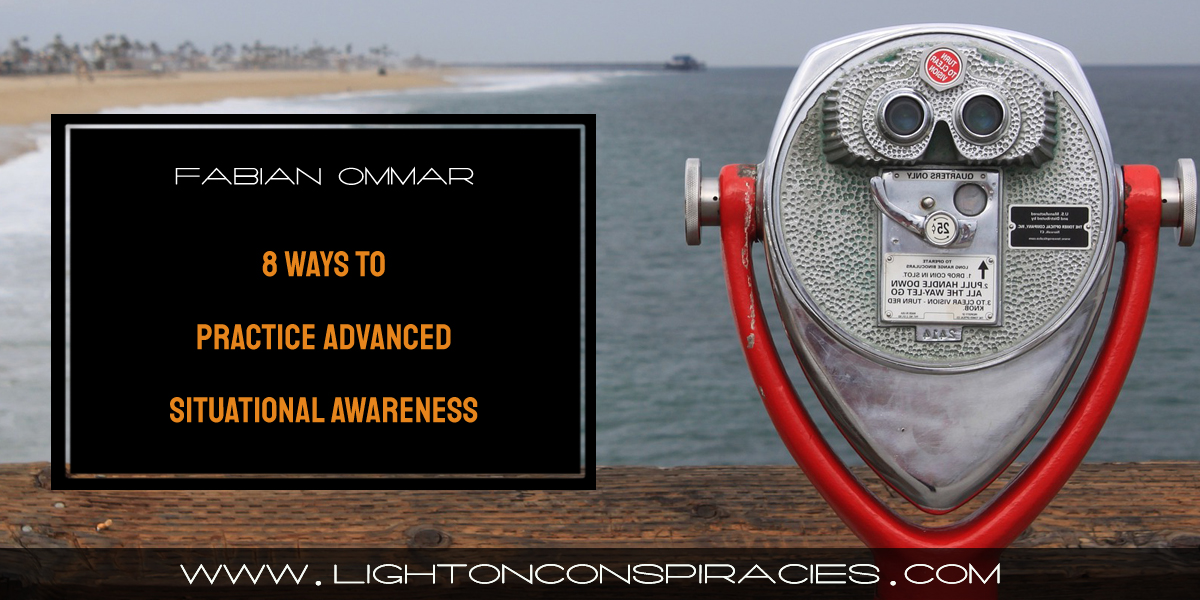 By Fabian Ommar
By Fabian Ommar
In one of my recently published articles, I defined situational awareness. I also presented a list of risks and threats commonly found in the urban environment and those posed by large and smaller groups of people and individuals. Selco, who survived in an urban setting, offers excellent examples of the differences between Urban Survival and Rural Survival as well as guidance for survival planning.
Here I will go over techniques for development and practices to improve situational awareness. Before we move ahead and get practical, let’s see one more aspect of situational awareness theory and psychology. Let’s also look at how it works in our minds to apply it in the most productive manners during training and everyday situations.
The four levels of awareness
I’m talking about awareness levels, which is a “scale” of alertness according to the context in which we find ourselves. There are several versions of this scale out there, all based on Col. Jeff Cooper‘s work. Cooper originally designed it as a practical guide for police and military agents who need to move fast between levels when readying for combat or violent action.
While I personally have some reservations about the way Cooper’s Color Code was adapted (and promoted) in the “situational awareness” concept, the scale’s idea is to provide a simple yet effective reference to ordinary people, and for that, it works. Besides, the levels of awareness help educate us on self-assessment and control.
It is essential to note the mind can’t operate in constant states of high alertness. Too much stress for too long is detrimental to our performance and even our health. Besides, it’s practically impossible to maintain a high level of awareness for long periods. We must learn to adjust, dial down or up as the context changes, and as our mind/body requires.
- Level 1: Relaxed – When (for instance) we’re at home watching a movie, focused on the TV, and tuned out to the rest.
- Level 2: Relaxed Awareness – There’s no significant threat, but we are aware of the situation around us, usually because we’re performing some task that demands some attention (as when driving and paying attention to what’s going on around, other vehicles and people moving and signaling (or not) their intentions, etc.).
- Level 3: Focused Awareness – The situation demands a higher level of focus (for example, when driving in the snow or a heavy storm, at night or through a poorly conditioned road with hazards)
- Level 4: High Alert – Thing’s have gotten scary. We recognize an actual or imminent threat and become ready to act. It can be fight, hide, or flight. At this level, we’re still able to function.
Above Level 4, there’s paralysis, panic-induced freeze, and comatose. Our senses get overwhelmed, and the rush is too big to cope, so we “shut down” as an automatic defense mechanism takes over.
Here is a bit of advice for preppers on how not to let anxiety paralyze you.
Know your limits and adapt accordingly
Moving abruptly between levels or jumping stages too quickly is what can cause break-outs. We go from Level 1 to 2, or 3 to 4 without a problem. But moving from, say, Level 1 to Level 4 in a snap can cause a short-circuit. There are techniques and training to deal with quick shifts in mental state, which, as said before, is the original proposition of the Cooper Color Code.
But there are limits, and even trained professionals can become paralyzed in some situations. That’s why we must learn and practice to “enter” the level of awareness best indicated to each situation and move or “flow” between the levels. It can become more natural and automatic once we become more aware. We reduce the chances of getting caught by some unpleasant surprise. (Read more here.)
Even SHTF and other dangerous situations will allow for periods of relaxation. Maybe not “Level 1” total relaxation, but more acceptable or perhaps manageable levels that still provide the awareness required by the situation and the relaxation needed by the mind.
Cognitive systems of the brain and how it concerns us and situational awareness
Our brain has two systems. One is the “automatic,” responsible for the majority of our daily tasks. It is intuitive, multitasking, and economic (demands less energy/time to decide). The other is the “deliberate” system, which handles analytical decision-making. It can only process one choice at a time (more focus) and is more energy/time-consuming.
Understanding this is useful for decision-making and also developing new skills. When we start something new, our “analytical” mind gets busy analyzing every individual aspect of the task at hand. In this phase, we’re slow and clunky. Once we repeat enough, the “automatic” mind takes over, and we no longer need to focus on every detail (or any at all) to perform the task. We become fluent, fast, and smooth.
Situational awareness doesn’t mean just becoming aware. It implies running scenarios and analyzing possibilities, arriving at a conclusion, and taking action to achieve the desired outcome. There’s a decision(s) involved. For this entire process to become useful and effective, it must be done fast and efficiently by the “auto” system. To get there, we must practice and repeat the steps necessary individually.
In short, we must practice focusing on one or two aspects at a time until it becomes internalized and natural. It will then be an acquired ability, and our brain will work automatically in a fast, comprehensive, efficient, and intuitive manner. That should be our final objective.
Techniques for Situational Awareness Training
Practice and training don’t mean willfully chasing dangerous situations, but rather exposing ourselves to everyday situations and interactions with focus and intent, purposefully working on these aspects and skills as explained above.
Disclaimer: Please note this is from a common-man perspective. I’m not a specialist. These are the techniques I have used myself and with others I have successfully guided. Situational awareness is not rocket science. It is a vast topic, though. If you believe you need advanced or specialized training for some reason, look for professional orientation or enroll in a tactical course.
1. Stay informed
We begin to become aware by staying connected to our world, tuned to what’s happening in all the different levels of our reality: neighborhood, city, state, country, and international. Like it or not, current events and prepping are inextricably entwined.
- Locally, it’s best to do your own work and keep in contact with the people in your community. Be casual and generic, rather than intrusive or particular. The aim is to be on top of situations concerning infrastructure, the chain of supply, security, etc.
- On the macro level, stay informed about political, geopolitical, social, and economic scenes. Here the idea is to zoom out and have a general picture of developments in the world. It’s OK to focus on topics that have the potential to affect us directly. For this, choose your sources wisely and separate noise from signal (another skill).
2. Head on a swivel
Having “eyes in the back of your head” is a beneficial skill. No one has to turn into an international spy. Still, techniques for “looking around” or specifically spying on someone or somewhere (without giving the impression that we’re focused or too intent on doing so) are essential.
- Some people take this as a cue to look around every 10 seconds, searching for danger. Doing so draws unwanted attention and makes us look paranoid or frightened in the eyes of others. Act casual, relaxed, but attentive and decided. Avoid looking worried, scared, or anxious.
- Use shadows, mirrors, and glasses in buildings, storefronts, vehicles, bus stops, etc., to casually and discreetly glance around. Our peripheral vision is a powerful ally too. All the time, I pretend to look at something on a store window or whatever to spy on what I actually want with the corner of my eyes.
- Every once in a while, take a look back and to the sides, calmly but assuredly. Being intentional indicates we are alert and attentive.
- A slightly more discreet tactic is to use noises such as other people or passing vehicles to turn my head and look around. This way, I can scan the surroundings or peek at something or someone without staring directly.
- Use your phone in a planned, deliberate way. For instance, pull it out while turning your back against a wall or store entrance (to avoid being surprised from behind) and pretend you’re talking to someone or reading, texting, etc., while you scan around or look at people or places more deserving of your attention.
- The power of darkness: during the daytime, I’m always wearing sunglasses, even when overcast. Mostly because I feel comfortable, but also to hide the direction of my sight.
This is a great way to learn how to be more observant.
3. The right attitude
It’s vital to achieve a balance here: not confrontational and not appearing like a victim. Being confident is different from being cocky. Most of the time, people (especially street people) can tell between someone aware, confident, and capable of handling him/her self and someone faking toughness. Never underestimate the capacities and abilities of others, no matter what.
- Capable and self-reliant people don’t pick fights, don’t provoke, don’t take offense from random and impersonal provocations and attacks, don’t lock eyes in defiance (or fear), and above all, don’t have anything to prove. On the contrary: if you see a person moving away or calmly trying to avoid confrontation or de-escalate a situation, it’s probably someone with serious self-defense training. Bruce Lee famously said, “The most dangerous person is the one who listens, thinks and observes.”
- Whatever happens and whoever is on the other side, if we want to survive, we need to avoid danger. Situational awareness is crucial for achieving that. Showing you’re aware and tuned is an excellent way to hold off potential attackers. Criminals will always favor surprise and thus prefer to prey on distracted people. For them, it’s a matter of risk/reward, and the risks are more considerable when someone can anticipate their moves.
4. Entering and exiting
These are common situations that can involve higher risk/vulnerability, depending on the settings. Entering and exiting places require Level 2 or 3 for a few moments to look at routes, hidden risks, potential threats (which can be anything like other people and moving vehicles), and even ongoing works (for instance, around or near construction sites).
- Whether driving or walking, we should make a habit of searching the surroundings with attention when leaving or entering garages, buildings, etc. Not only to avoid being robbed or attacked but also to prevent collisions and other accidents.
- One common situation preferred by thugs and robbers is someone entering or leaving their vehicles. Most people do this in automatic mode, often while searching for the keys, talking on the phone, grabbing a piece of clothing or a purse, or in a hurry. Don’t be like that. Have everything at hand and ready before heading to/from the car and remain focused and aware until safety is reached.
- We can also be attacked while stuck in traffic or at a stoplight. Focus on driving, be ready and stay alert for suspicious people or activities at all times in these situations, particularly when going through locations that may present a risk for attacks, accidents, or are known crime/accident spots.
5. Evaluating people
We must know how to analyze strangers from what we can pick, recognize between real and fake threats and non-issues, and adjust and act accordingly. It is essential in the streets.
- One common mistake is judging based on looks alone. Some criminals know that people do this and use “reverse grey man tactics,” i.e., they make a deliberate effort to blend in and fool their victims and the authorities. Some are very efficient at blending in; therefore, appearance alone may not cut it.
- Analyze demeanor, body positioning, stance, how everyone treats personal space (theirs and others), where and whom they lock their eyesight on, things like that. Pay attention to clothing details, how the person scans the surroundings, how they walk, etc. Overall, we should look for “oddities” in other people’s appearance and behavior.
- Avoid personal judgment or emotional assessments: this should be as impersonal, objective, impartial as possible to have some use.
- Everyone should be treated with equal respect. But in the streets, there are all kinds of people and everyone is a stranger. Each type of person and interaction demands a specific positioning on our part. I’m talking specifically in regards to reaction. For the most part, we should leave other people alone unless contact is needed for some reason.
6. Rehearse situations
Back in the early 2000s, I took part in the local community safety council. I’ve had a previous experience taking part in the neighborhood watch group while studying in Colorado a few years before and tried to introduce the concept to my local scene. It didn’t work in the end, but the research I did to make that presentation was of great personal value.
Chuck Remsberg’s seminal The Tactical Edge – Surviving High-Risk Patrol stands today as a reference for tactical evaluation, training, and dealing with life-threatening situations. It’s complex, thorough, and extensive (as are all great works) and was written for police training. But the lessons and information provided are helpful for everyone living in a big city. It has some great insights and valuable knowledge for preppers.
Remsberg uses “mental movies” to describe what he calls “crisis rehearsal.” Business people, negotiators, and salespeople also use this technique. It is essentially conjuring up and visualizing situations, “playing” in our minds what we’d do, how we’d act, and what we’d say to come out on top and achieve the desired outcome (winning). I like to imagine and play out what this person would say or do and what I would say or do in response. Daisy recommends doing just this when watching survival-related movies.
There’s, of course, a physical side to being prepared to deal with a real-life situation, whether it’s some martial arts training or another self-defense discipline (firearms, tactical combat, etc.). One must be prepared and trained to act. But here, we’re specifically dealing with the mental aspect of this preparation, which is related to situational awareness in essence—for that, playing and rehearsing situations while in the streets can be very effective.
7. Practice
“We don’t rise to the level of our expectations. We fall to the level of our training.” This quote, attributed to the ancient Greek poet Archilochus, is one of my favorites. It reminds me of the importance of constant practice. Use it or lose it. In all these years guiding and helping others in street survival training, I’ve seen people improve significantly. Many went from totally tuned-out and oblivious to incredibly sharp and aware.
The best and most effective way I’ve found to practice the skills listed here is to walk and spend time in the streets, often with the homeless. It may seem obvious, but it’s not something easy when we’re out there: there are too many distractions, and early on, we have difficulty staying focused on the task at hand for even fifteen or thirty minutes.
But it’s just like working out: as time passes, we naturally become better, stronger, more fit. The same happens with our awareness if we keep at it (walking has the bonus of improving our fitness).
- The most significant advantage of walking is the speed: it’s the slowest we can travel, which allows for greater attention to the surroundings. When we’re skating or cycling or even running, we must focus a lot on movement around us to avoid obstacles. Walking frees us from a lot of that to focus on whatever we want and practice the skills.
- One good exercise is to pause from time to time and stay put, paying attention to what’s going on around. Sit down on a bench, bus stop, anywhere with some movement. Do that in different places and areas around town: commercial, corporate and residential regions, parks, train and metro stations, plazas, shopping centers, museums, etc.
- Situational awareness should also be practiced in everyday situations: when leaving home, driving to places, strolling in the mall, going for lunch or dinner, everywhere. The practical, real-life application of situational awareness is the main objective. Doing so internalizes awareness and turns it into a mental state. Once it becomes natural, we’ll be more apt to move between attentiveness levels and remain in better control of our focus and emotions.
8. Trust your instincts
Finally, no amount of skill or practice will help if we don’t trust ourselves. Follow your gut and act upon it. Don’t worry about being polite. At the core of any and every kind of training, physical or mental, in every discipline is instinct. Situational awareness is a tool: the more we sharpen it, the more reliant and confident we should be to perform when the situation presents itself.
Yet, we’re not in this to be right but rather to be safe. For that, we must act. Don’t worry. Acting comes naturally. But stay alert and conscious of this vital aspect from now on, especially during training.
Conclusion
These are the main elements of situational awareness, according to my experience and knowledge. As always, there’s a lot more to be said about it. (I could go on and enter the specifics of urban ‘zoning’ (analyzing the heterogeneity and different aspects of the city to determine dangerous/safe areas and routes), how to develop an information network to collect “street intel”, resource mapping, the importance of educating others about awareness for collective/community safety and more.)
These and other strategies are explained in more detail in my book, but if there’s interest, drop a note in the comments below, and I’ll do another article exclusively on these topics. Perhaps even illustrating with some real stories to explain how these principles work in real-life situations. For now, stay safe and share with the community your tips and experiences on situational awareness. I’d be interested in hearing those too.
How do you enhance your situational awareness?
What are some ways you work on your own situational awareness? Do you practice with family members? Please share tips and questions in the comments.
Fabian Ommar is a 50-year-old middle-class worker living in São Paulo, Brazil. Far from being the super-tactical or highly trained military survivor type, he is the average joe who since his youth has been involved with self-reliance and outdoor activities and the practical side of balancing life between a big city and rural/wilderness settings. Since the 2008 world economic crisis, he has been training and helping others in his area to become better prepared for the “constant, slow-burning SHTF” of living in a 3rd world country.
Fabian’s ebook, Street Survivalism: A Practical Training Guide To Life In The City, is a practical training method for common city dwellers based on the lifestyle of the homeless (real-life survivors) to be more psychologically, mentally, and physically prepared to deal with the harsh reality of the streets during normal or difficult times.
You can follow Fabian on Instagram @stoicsurvivor













